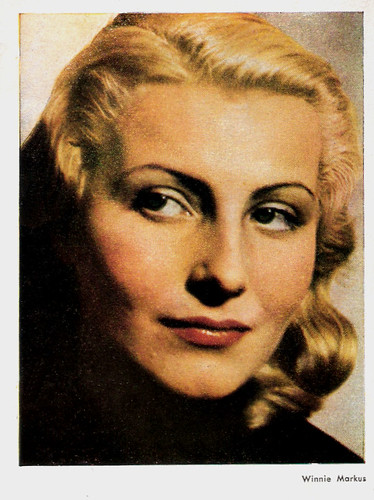
German postcard by Verlag und Druckerei Erwin Preuss, no. 17. Photo: Charlott Serda.

German postcard by Film-Foto-Verlag, no. G 223, 1941-1944. Photo: Berlin-Film / Foto Binz.
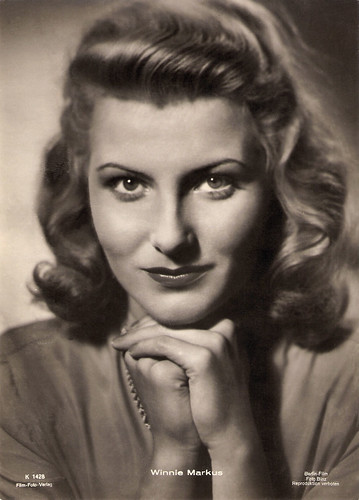
Big German card by Film-Foto-Verlag, no. K 1428, 1941-1944. Photo: Berlin-Film / Binz.

German collector card in the 'Deutsche Film-Lieblinge' series I.
Mozart
Winnie Maria Eveline Markus was born in Prague, Czechoslovakia (now the Czech Republic), in 1921. Her family belonged to the German population that remained in Czechoslovakia after the collapse of the Austria-Hungarian Dual Monarchy. She lived till her 14th year in Prague, where her father worked as an export merchant. At 16, she went to Vienna to be trained at the Max Reinhardt Seminar.
After finishing her training, Markus made her stage debut as an elf in William Shakespeare's 'Sommernachtstraum' (A Midsummer Night's Dream) at the Theatre in der Josefstadt in Vienna in 1939. Soon she made a name for herself on the Viennese stage. Till 1945, she was engaged at the Theater in der Josefstadt, later followed engagements in Berlin and in Munich.
Her film debut was a small part in Mutterliebe/Mother Love (Gustav Ucicky, 1939) featuring Käthe Dorsch. That same year, she played her first lead role in the adventure film Brand im Ozean/Fire in the Ocean (Günther Rittau, 1939) opposite Hans Söhnker and René Deltgen.
During the period of the Third Reich, she starred in 25 Ufa films, including Das alte Lied/The Old Song (Fritz Peter Buch, 1945), based on a novel by Theodor Fontane and filmed in Amsterdam and The Hague. In the biography Wen die Götter lieben/Whom The Gods Love (Karl Hartl, 1942), she played Konstanze, the wife of Wolfgang Amadeus Mozart (Hans Holt). But the film was shelved, unfinished when the war ended.
After the war, producer Abrasha Haimson bought the rights, hired director Frank Wisbar and filmed new scenes to finish the picture. In 1948, he released it as a new film, The Mozart Story.
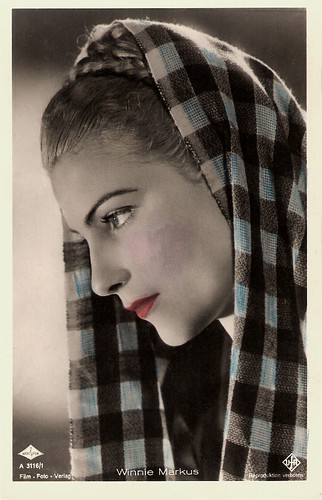
German postcard by Film-Foto-Verlag, no. A 3116/1, 1941-1944. Photo: Wien-Film / Ufa.
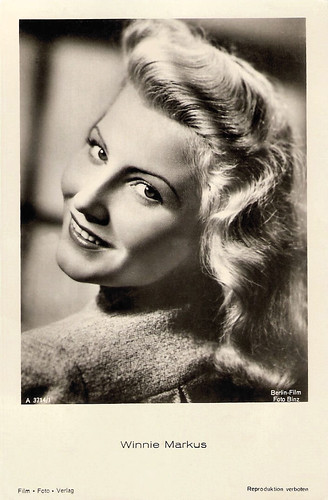
German postcard by Film-Foto-Verlag, no. A 3714/1, 1941-1944. Photo: Binz / Berlin-Film.
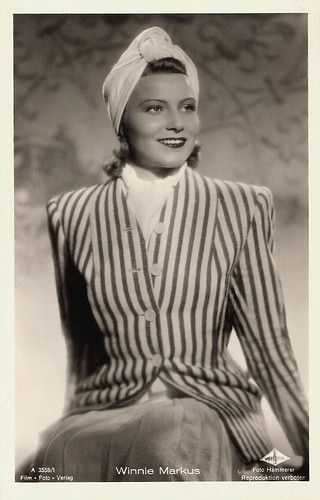
German postcard by Film-Foto-Verlag, no. A 3558/1, 1941-1944. Photo: Hämmerer.
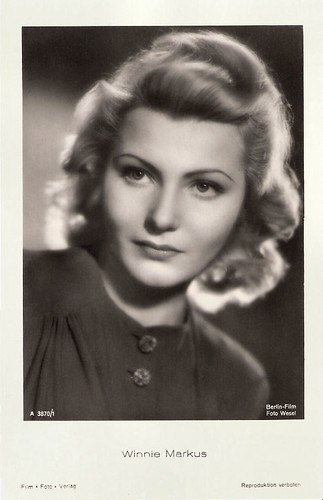
German postcard by Film-Foto-Verlag, no. A 3870/1, 1941-1944. Photo: Berlin-Film / Wesel.
Anti-Nazi films
Despite her past as an Ufa star, Winnie Markus could go on playing after the war in many stage plays and films, even in such anti-Nazi films as In jenen Tagen/In Those Days (Helmut Käutner, 1947), Zwischen gestern und morgen/Between Yesterday and Tomorrow (Harald Braun, 1947) with Hildegard Knef, and Morituri (Eugen York, 1948) with Walter Richter and Lotte Koch.
These Trümmerfilme (German Rubble films) examine the issues of collective guilt and future rebuilding. They were made directly after World War II and showed the impact of the ravages of the war on the countries at the centre of battle. Their style is characterized by its use of location exteriors among the 'rubble' of bombed-down cities to bring the gritty, depressing reality of the lives of the war survivors. With Rudolf Prack, Markus became one of the most pretty pairs of the Heimatfilm genre during the 1950s. Their films together included Kaiserwalzer/The Emperor Waltz (Franz Antel, 1953) in which she played a beautiful teacher who falls in love with the dashing Archduke Ludwig.
Markus' other well-known films are the crime thriller Teufel in Seide/Devil in Silk (Rolf Hansen, 1956), Der Priester und das Mädchen/The Priest and the Girl (Gustav Ucicky, 1958) and Was eine Frau in Frühling träumt/What Women Dream of in Springtime (Erik Ode, Arthur Maria Rabenalt, 1959). Her co-stars were actors like Curd Jürgens, O.W. Fischer and Paul Hubschmid.
She married twice. In 1946 she wed the Berlin hotel owner Heinz Zellermayer. Their son Alexander was killed in a traffic accident in 1982. In 1959 she married contractor Aldi Vogel. Their daughter Diana Winnie later also became an actress. After the birth of Diana in 1961, Markus retired as an actress. The following decades, she regularly represented her husband in his imperium, but after the collapse of his contracting firm she made her come-back as an actress in 1980.
Winnie Markus was still popular and in demand, and worked often for TV. In 1986 the German film world awarded her with the Filmband in Gold for her entire career and in 1988 she was awarded with the Bundesfilmkreuz. In 2002 Winnie Markus died from a lung infection in Munich, Germany.
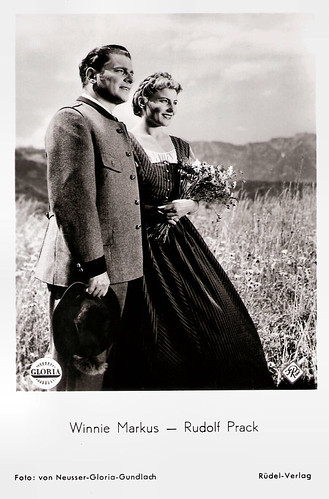
German postcard by Rüdel-Verlag, Hamburg-Bergedorff, no. 607. Photo: Von Neusser / Gloria / Gundlach. Publicity still for Kaiserwalzer/The Emperor Waltz (Franz Antel, 1953).
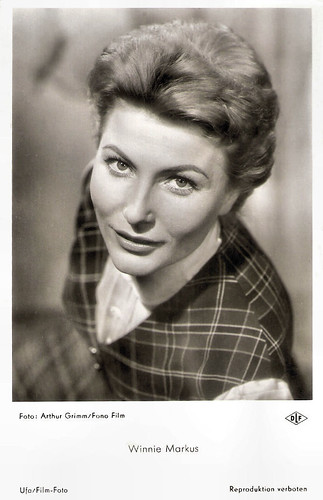
German postcard by Ufa, Berlin-Tempelhof, no. FK 1983. Photo: Arthur Grimm / Fono Film / DLF. Publicity still for Teufel in Seide/Devil in Silk (Rolf Hansen, 1956).

German postcard by WS-Druck, Wanne-Eickel, no. F 39. Photo: Bayer.
German postcard by ISV, no. C 6. Photo: Gloria / Bayer.
Sources: Ruud van Capelleveen (Absofacts2 - Page now defunct), Stephanie D'heil (Steffi-line - German), Winnie Markus.de (German - Now defunct), Wikipedia (German and English), and IMDb.
This post was last updated on 14 May 2025.
No comments:
Post a Comment